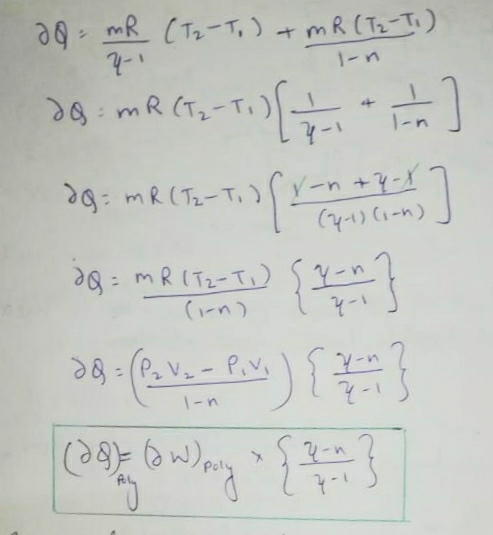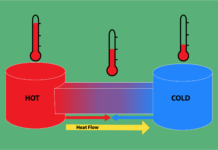In the thermodynamics it is very important to understand the phenomenon of heat transfer .
Heat is a boundary phenomenon and it is said to be transferred only when it crosses the boundary .
In detail we had discussed about heat transfer in previous post
Heat transfer for different thermodynamic processes :
(a) Isochoric process :
In Isochoric process volume remains constant.
i.e.,. V = constant
Therefore , dV = 0
And hence , ∆ W = 0
from first law of thermodynamics :
∆Q = dU + ∆W
As ∆W = 0
Therefore ,
∆Q = dU
and
dU = mcv dT
and it is valid only for :
• Volume = constant, any gas
OR
• Ideal gas , any process
Note :
For Isochoric process, heat transfer is equal to the change in internal energy.
(b) Isobaric process :
In Isobaric process , pressure remains constant.
i.e., P = constant
therefore ,
∆W = P ( V2 – V1 )
and dU = U2 – U1
From first law of thermodynamics ,∆Q = dU + ∆W
∆Q = U2-U1 +P(V2-V1)
∆Q = ( U2 + P2V2 ) – ( U1 + P1V1 )
∆Q= h2 – h1
Therefore ,
∆Q = dh
and
dh = mcpdT
The above result is valid for :
• Constant pressure, any gas
OR
• Ideal gas , any process
Hence , at constant pressure heat transfer is equal to the change in enthalpy.
Note :
What is Enthalpy?
In thermodynamics the term U +PV comes frequently and it is known as Enthalpy .
Enthalpy denotes the total energy content of the system and it is
(a) Property of the system
(b)Point function
(c) Exact differential
(d) cyclic integral is zero.
(c) isothermal process :
In Isothermal process , the temperature of the system remains constant .
i.e., T = constant
As we know that the internal energy is the function of temperature
Therefore , dU = 0
As , ∆Q= dU + ∆W
∆Q= ∆W
This is valid for Isothermal process only.
(d) Adiabatic process :
In adiabatic process the net heat transfer is zero .
∆Q= 0
(e) Polytropic process :
In Polytropic process , the relation PVn = constant is followed .
∆Q = dU + ∆W
∆Q= mcvdT + ( P2V2 – P1V1)/(1-n)
As it is valid for ideal gas only
we know that ,
cp – cv = R and cp/cv = ¥
Therefore ,
cv = R/(¥-1) and cp = ¥R/(¥-1)

∆Qpoly = ∆Wpoly × ( ¥- n )/(¥ – 1)
This is valid for polytropic process , with Polytropic index n .





![[Free] Thermodynamics Course With Certification Thermodynamics](https://mechomotive.com/wp-content/uploads/2021/01/SAVE_20210121_225241-218x150.jpg)